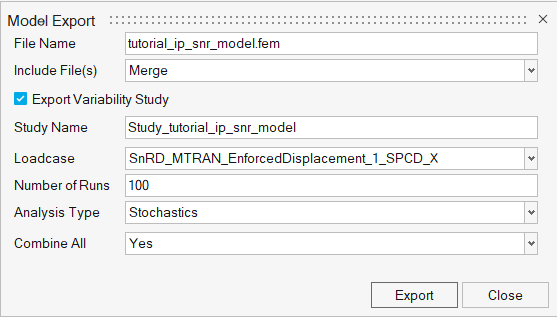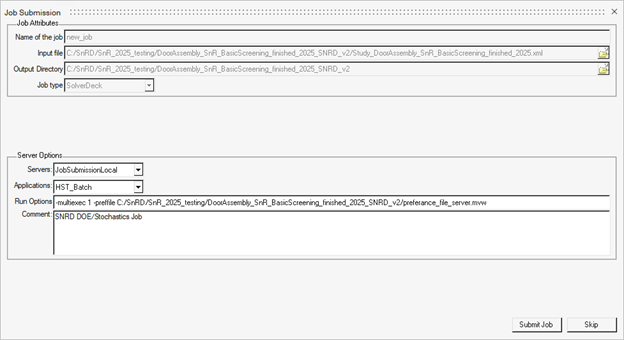Model Export
Use the Export tool to export loadcases and variability studies.
-
From SnRPre ribbon, Analyze
group, select the Export tool from the Run tool
group.
Figure 1.  The Model Export dialog opens.
The Model Export dialog opens.Figure 2. 
- Enter the file name.
- For Include File(s), select Preserve or Merge.
- Click Export.
-
Browse and select the required folder.
Note: During the solver file export, SnRD also exports E-Lines information to a CSV file. This file will be used in the post-processing of results.Tip: If you have not mapped material or GD&T data to E-Lines in the session, these can be manually updated in the CSV file after export and before post-processing.Restriction: If Include File(s) is set to Preserve, then all E-Lines and related information must be located main file. Post-processing is dependent on this.This will export the OptiStruct solver deck to the selected folder.
- Model file(s) (.fem) along with a _preoutput.csv file are exported to the selected folder.
- If Variability study is selected then, SnRD will also
export the following:
- .tpl file: Parametrized version of the model file.
- .xml file: Study file containing HyperStudy setup.
Export Variability Study
If a variability study is created in the session, an additional export option is available to allow for export of a variability study session which can be opened in HyperStudy to run a Stochastics or DOE study or in batch mode.
-
From SnRPre ribbon, Analyze
group, select the Export tool from the Run tool
group.
Figure 3.  The Model Export dialog opens.
The Model Export dialog opens.Figure 4. 
-
Select the Export Variability Study check box.
Figure 5. 
- Enter a name.
- For Loadcase, select the Dynamic Event to run in the study.
-
For Number of Runs, define the number of runs.
Note: The number of runs is automatically assigned by SnRD based on the number of studies and the number of variables. You can edit this value, but it is not mandatory.
- Select an analysis type.
- Select an option for Combine All.
-
Click Export.
The Job Submission dialog opens.Note: In the Job Submission dialog, you can export the variability to run in batch mode locally.
Figure 6. 
-
Under Server Options, select JobSubmissionLocal.
Important: Compose is required to perform the variability study in batch mode.
- For Run Options, define or edit any extra run options.
- Add comments.
- Click Submit Job.
Note: Use the
open .xml file in HyperStudy to
generate a run database and results required for DOE/Stochastics study.
The
variability study TPL and XML files along with the OptiStruct solver file are exported to the selected folder.Export Solver File Options
- File Name
- Solver file export name.
- Include File(s)
- Select exporting of include files.
- Pre Output CSV
- CSV file containing the E-Lines definition.
